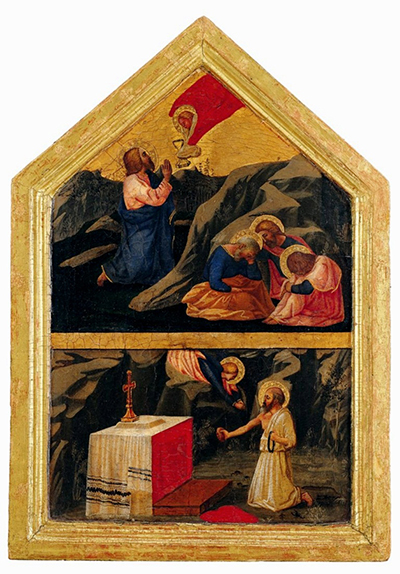 Buy Art Prints Now
Buy Art Prints Nowfrom Amazon
* As an Amazon Associate, and partner with Google Adsense and Ezoic, I earn from qualifying purchases.
The innocent artwork dates back to 1426 as a part of the Early Renaissance Era
Masaccio is considered the best painter of his generation based on his ability to imitate life, nature, and beauty within his work.
The artist began creating his artwork on a linear perspective that captured figures in a two dimensional form, yet later moved onto illustrating his artwork in a three dimensional form. The Agony in the Garden illustrates this surreal technique as Masaccio is able to illustrate and array of stories within the art piece.
The Agony of the Garden refers to a few of the most significant events of Jesus's life as recorded within the New Testament. The fresco painting illustrates Jesus in two scenes as an written within the New Testament.
The upper fresco of the painting manifests Jesus kneeling as he prays to an angel who appears in front of him. He is dressed in a dark blue fabric that wraps around his body, with a glimpse of a pink fabric covering his body.
Masaccio depicts a few other figures near the right of the painting as they sit and mourn the arrest of their leader. These individuals are dressed in bright coloured fabrics, adding an array of colour to the piece. These figures are said to be JesusÕs apostles, as Masaccio paints them with a golden aurora around their head showcasing their holy status.
Masaccio carried a gifted ability to be able to display natural settings throughout his artwork, as showcased within the Agony of the Garden. These large rocks within the background of the artwork add a calmer feel to the artwork while adding drama through the dark colours used. Masaccio creates a contrast between these dark colours by painting the sky in a golden colour, adding more depth and emotion within the artwork.
Masaccio spent a great deal of time illustrating the dark rocks within the painting as he contours the figures of the rocks creating a three-dimensional painting. Alongside, the red colour in which the angel is coloured in seizes the viewer's attention as Masaccio used a captivating shade of blood red.
The bottom section of the painting illustrates an additional scene that belongs to the testament describing the events that occurred within Jesus's death. A holy figure kneels against an alter as he prays to a large cross on the table, mourning the arrest of Jesus. The character seems to resemble a priest, as he is clothed in a white fabric while holding a rosary within his hand.
The alter is placed in a natural setting outside, showcasing the difficulties at the time to practice the Catholic religion as some were persecuted. The viewer is able to witness an angel appear as she reassures to the figure that the arrest of Jesus does not symbolize the end.
Masaccio created an array of biblical frescos throughout his artistic career, as seen in some of his most prominent work such as St. Paul, St. Andrew, and Maria and Child.




